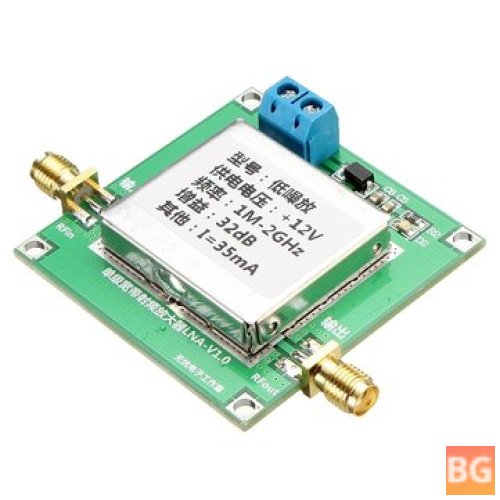The 12V Broadband RF Amplifier has impressive specifications with a gain of 32dB and a power supply voltage of DC 12V.
Its ability to amplify signals across a wide frequency range from 1M-2000MHz to 2Ghz makes it a versatile tool for a range of applications. Although, the input signal may become distorted if it exceeds the recommended threshold. The pros of this product include high gain, low noise performance, and wide frequency range. Overall, we would recommend the 12V Broadband RF Amplifier to anyone looking for a reliable and high-performing broadband RF amplifier.
Before we dive into the review of the 12V Broadband RF Amplifier let's take a moment to appreciate its impressive specifications.
With a gain of 32dB and a power supply voltage of DC 12V (Current 35mA), this amplifier module is designed for low noise and high performance. Its input and output impedance of 50 Ohm, along with its maximum output power of 10 dBm (2VPP50Ohm load), make it a versatile tool for a range of applications.
One of the key strengths of the 12V Broadband RF Amplifier is its ability to amplify signals across a wide frequency range from 1M-2000MHz to 2Ghz. This makes it suitable for use in various wireless communication systems, such as radios, transmitters, and receivers. The amplifier module is also designed with a shielded enclosure that helps to reduce electromagnetic interference and ensure a stable output signal.
In terms of performance the amplifier module delivers on its promise of low noise amplification, with an input signal threshold of ≤-22 DBM. However, it's worth noting that if the input signal exceeds this level, the output signal may become distorted. Overall the amplifier module is well-made and sturdy, and should withstand regular use.
Overall the pros of the 12V Broadband RF Amplifier include its high gain, low noise performance, and wide frequency range. It's also reasonably priced compared to other similar products on the market. However, one potential drawback is that if the input signal exceeds the recommended threshold the output signal may be affected. Additionally, some users may find that they need to purchase a separate 12V adaptor to use the amplifier module.
In the end it's clear that this product is worth checking out for anyone in need of a reliable and high-performing broadband RF amplifier. While there are some potential downsides to consider, such as the need for a separate adaptor and the limitations on input signals, these are relatively minor compared to the overall benefits of the product. Overall, we would recommend the 12V Broadband RF Amplifier to anyone looking for a versatile and well-made amplifier module that delivers on its promises.

